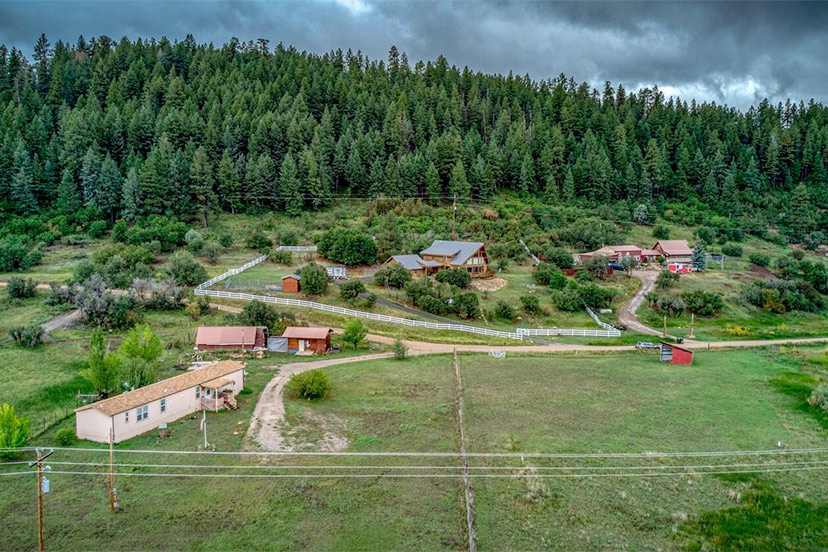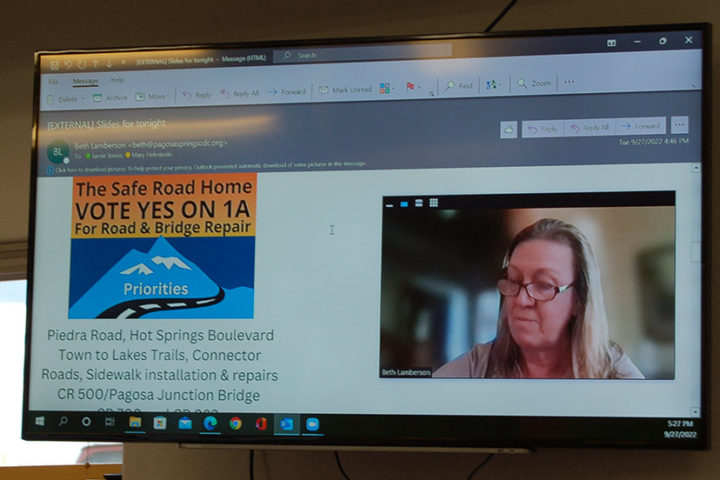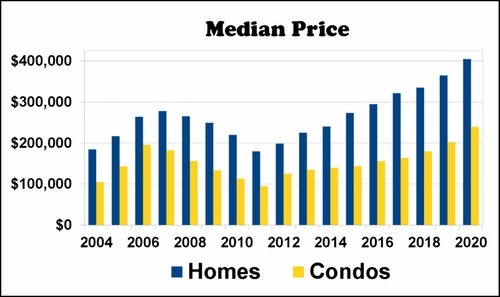PHOTO: A rural road in Aspen Springs Subdivision.
“Americans generally believe in fairness.”
That sentence, occurring as it did yesterday in Part Four of this editorial series, is not a ‘fact’. It’s a belief I happen to hold, based on my personal experiences.
The word, “generally”, applies not only to the number of Americans who believe in fairness, but also to the frequency. A person can generally believe in fairness, just as they can believe, generally, in abiding by the law — but situations can arise where something other than fairness seems more important. Situations can arise, when it seems appropriate, for whatever reason, to violate the law. There are exceptions to the rule, in other words, even for a person who generally believes in doing what’s right.
One of those exceptions seems to have arisen at the County Administration building this past week. The fairness exception. And the violation of the law exception.
I probably wouldn’t be making a fuss about these exceptions, except that the issue at hand is a $6.5 million sales tax increase… which would likely amount to $85 million over the next ten years, and even more in the future.
But before we discuss possible unfairness and violations of Colorado law by our County government, I’d like to finish the discussion about how to fix community problems, without causing stress to people struggling to meet their human needs in Pagosa Springs. Because fixing problems often requires money, and when the problem is “someone else’s problem”, we often feel that the “someone else” ought to pay for it.
The community problems of most concern, in my humble opinion, are road maintenance and lack of housing for our workforce. And there are various approaches to solving these problems.
Different ways to skin a cat, you might say.
For example: the community of Aspen Springs, 10 miles west of downtown Pagosa Springs, is reportedly the second largest subdivision in the United States. It’s also one of the most ‘rural’. The developers who created the subdivision didn’t bother with minor details like decent roads, utilities, running water and community sewer services, and Archuleta County, back in 1970, didn’t have land use regulations that required such minor amenities. We were still the Wild West back then.
52 years later, Aspen Springs still doesn’t have running water or sewer service. They have electricity (thank goodness) and a new cell/broadband tower was installed last year, giving them the ability to send a text message to their favorite water hauling service.
The roads in Aspen Springs? That’s another matter entirely. The dirt roads built by the original developers were so terrible that Archuleta County simply refused to maintain them. So in 1987, the residents voted to form the Aspen Springs Metropolitan District. The Metro District has three employees (last I heard) and provides road maintenance and snow plowing services for 65 miles of road. Some of the best-maintained roads in Archuleta County, we should note.
For comparison, Archuleta County has a total of 320 miles of county roads — almost all gravel. Almost all in ‘fair to poor’ shape.
The Aspen Springs Metro District is funded by a 15 mill property tax, which is on top of the 17 mill property tax the residents pay — as do all Archuleta County property owners — to the County government. We note that, although Aspen Springs residents pay property taxes and sales taxes to the Archuleta County government, they get no road maintenance in return. Zero. They pay for their own maintenance and plowing.
What do they get for their 17 mills paid to the County? Occasionally, the Sheriff comes out and busts a couple of pot growers. That’s about it, folks.
Several other Pagosa Springs neighborhoods also pay extra property taxes to fund their own metro districts. Alpha Rock Ridge residents pay 10 mills, as do Loma Linda residents, and Colorado Timber Ridge residents. In San Juan River Village, residents pay 9 mills. Piedra Park pays 7 mills. (These numbers are rounded off.)
By almost everyone’s standards, Archuleta County has done a mediocre job of maintaining our roads over the past 20 or 30 years, even though their budget has grown by a rather staggering amount. 20 years ago, in 2003, the County budget was $13.3 million. This year, the County budget expects to spend $43.1 million.
If the County budget had simply grown at the same rate as inflation, this year’s budget would have been $20.4 million. A person would be tempted to suggest that the cost of County government has grown at more than twice the rate of inflation..
Someone else might ask, “Then, why are our roads in worse condition than they were in 2003?”
Nevertheless, the government-sponsored Pagosa Springs Community Development Corporation (PSCDC) is promoting Ballot Measure 1A, to extract more sales tax from the taxpayers, using the catchy phrase, “The Safe Road Home”.
Right now, some of the safest roads are in metro districts, thank you. But a County sales tax increased won’t help the metro districts that maintain their own roads.
The PSCDC campaign will presumably avoid mentioning that the tax increase will be $6.5 million in 2023, and probably even more in successive years. The increased taxes will be paid mainly by retirees and working families.
Have our retirees and working families seen their incomes doubled since 2003? I think not. But they’ve seen their mortgage rates and rental rates double. They’ve seen their gas price double. They’ve seen their property tax rate double.
There’s more than one way to skin a cat, and a sales tax increase on struggling families is the worst possible way. It’s my belief that an increase in the number of metro districts would be a much better approach to the road maintenance problem, when we do an actual survey of which neighborhoods have the best-maintained roads.
Giving more money to the County government has been, historically, a dead end.
The other big problem in Archuleta County? Housing for residents. We have lots and lots of housing for tourists. Over the past decade or so, approximately local 1,200 homes have been converted into small private motels — vacation rentals, STRs — and the vast majority of them are typical two- and three-bedroom homes previously occupied by local residents or used by second-home owners. That conversion of residential homes to commercial investment properties has been partly responsible for the massive increase in rents and home prices. This chart from local realtor Lee Riley:
How should we skin this cat?



